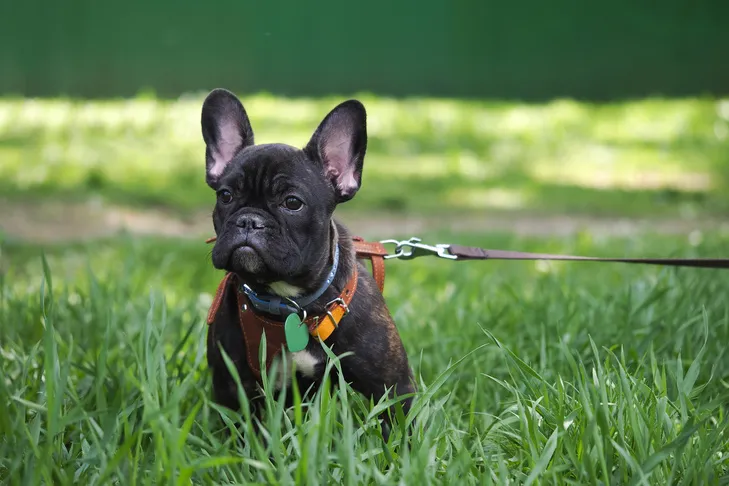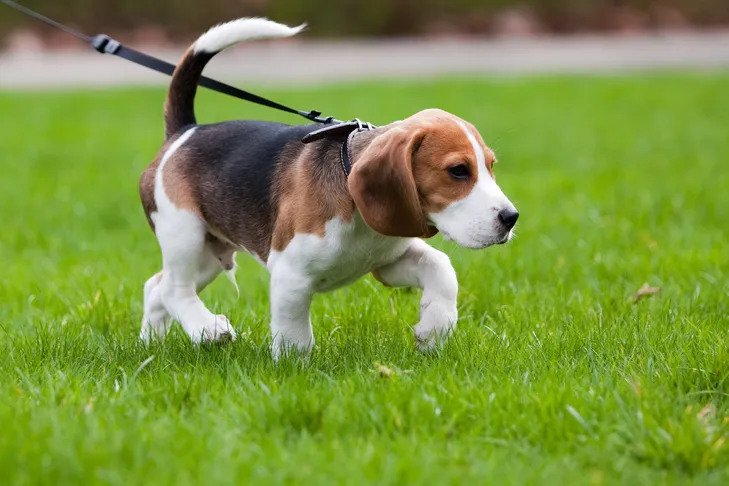Taking your new puppy for regular walks is crucial for their physical exercise, mental stimulation, and essential socialization. However, unlike what many new dog owners might expect, puppies aren’t born with an innate understanding of how to walk politely on a leash. While some might naturally trot alongside you, and others might enthusiastically pull ahead, there are many puppies who, the moment you attach a leash, freeze in their tracks. This common behavior often leaves owners wondering: why does the leash suddenly act like a stop sign for my little explorer, and How To Get Your Puppy To Walk when they’re so reluctant?
The truth is, many puppies are genuinely frightened, either by the unfamiliar sensation of a collar and leash or by the overwhelming sights, sounds, and smells of the great outdoors. This guide from Dog Care Story will help you understand the root causes of your puppy’s walking woes and provide actionable steps to transform their apprehension into confident, joyful strolls.
Understanding Puppy Leash Reluctance
For many young pups, the simple act of clipping on a leash can be enough to shut them down. A leash, at its core, is a form of restraint. When your puppy is tethered, they lose the freedom to roam where they wish or to escape from anything they perceive as frightening. This feeling of being controlled can be deeply intimidating for a small, vulnerable puppy. Instead of viewing the leash as a gateway to exciting adventures, they might see it as a scary object that limits their autonomy.
Similarly, even a collar can be a source of discomfort for some puppies. It feels strange and unfamiliar around their neck. If a collar has been used to roughly grab or pull the puppy, they can quickly associate it with negative experiences. Our goal, as responsible owners, is to ensure your puppy not only tolerates their collar but enjoys wearing it, associating it with comfort and positive attention. Building this positive foundation is the first crucial step in teaching them to love walks.
Step 1: Building a Positive Association with Collar and Leash
Ideally, a responsible breeder will have introduced your puppy to a collar and leash early on. However, if this hasn’t been the case, it becomes your important task to help your puppy feel comfortable and confident wearing them. Begin this process indoors, in a safe and familiar environment.
Start with short periods where your puppy wears just the collar, then gradually introduce the leash. During these times, offer plenty of praise, engage in gentle play, and reward them with delicious treats. This positive reinforcement helps them associate the collar and leash with pleasant experiences. You can also play the “Gotcha” game: gently grab your puppy’s collar (without pulling) and immediately follow with a favorite treat. Soon, your puppy will anticipate wonderful things when they see their collar and leash.
Initial Leash Training Indoors
Once your puppy is comfortable wearing the leash, you’re ready to teach them to move while clipped to it. Still indoors, use high-value treats to lure your puppy to walk a few steps towards you. As they move, praise them enthusiastically and reward them immediately. Gradually increase the distance, always keeping sessions short, positive, and full of rewards.
When your puppy confidently walks with you inside the house, you can then move your training to a confined, secure outdoor space like your backyard. After success there, slowly transition to the sidewalk, introducing them to new sights and sounds incrementally. Consistency and positive reinforcement are key during these early stages.
Step 2: Socializing Your Puppy to the Great Outdoors
As you advance training outside, remember that the “great outdoors” can be an overwhelming sensory explosion for a young puppy. All the new sights, unfamiliar sounds, and countless smells can be incredibly stimulating and, at times, frightening. Proper socialization is vital to help conquer your puppy’s anxiety and build their confidence in the world beyond your home.
 An adorable French Bulldog puppy wearing a harness and leash, sitting patiently in tall green grass, ready for its walk and outdoor socialization.
An adorable French Bulldog puppy wearing a harness and leash, sitting patiently in tall green grass, ready for its walk and outdoor socialization.
Introduce your puppy to a variety of people: different ages, sizes, and appearances (including those wearing glasses, hats, or using wheelchairs, as these can appear different to a dog). It’s also essential to expose your puppy to many different dogs and environments, always ensuring these encounters are positive and controlled. Never force an interaction. Let your puppy initiate contact at their own pace.
Pair every new outdoor experience with play, praise, and plenty of treats. This positive association helps your dog become comfortable with the world, teaching them to view new people and dogs as potential friends rather than threats. Remember, a well-socialized puppy is a confident puppy who is more likely to enjoy their walks. For specific outdoor routines, you might find tips on how to encourage your dog to pee outside or even teaching your dog to poop outside helpful.
Step 3: Making Walks Enjoyable (Beyond “Heel”)
Your puppy’s very first outdoor walks should be purely about fun and positive experiences. Don’t worry about perfecting a “heel” command just yet. Instead, encourage them to explore, sniff, and experience their surroundings. Give your dog the best walk possible by allowing them to investigate interesting smells and not rushing their bathroom behavior. Remember, the leash is primarily for safety, not initially for strict control. Your puppy won’t learn to love walks if you’re constantly pulling or correcting them.
It’s common for puppies to drag their heels or pull backward at first, especially when they’re still processing the new environment. Don’t stress about teaching a loose-leash walk until they are happy and eager to move forward on their own. By keeping these early walks positive, fun, and exploratory, your puppy will quickly start to feel excited whenever the leash comes out. Once they consistently show enthusiasm for walks, you can then gradually introduce more structured training for polite walking behavior. This gradual approach is key to developing a lifelong love for walks. If you’re also working on potty training outdoors, consider looking into guides on how to make your dog go to the bathroom efficiently during walks.
Advanced Tips for Reluctant Walkers
If you’re still finding it challenging to get your puppy moving on a leash, consider these additional tricks:
- The “Walk Back Home” Method: Carry your puppy 20 or 30 feet away from your home, then gently place them down and encourage them to walk back on their own. While they’ll still encounter the same external stimuli, the comfort of knowing they’re heading home to safety often provides the motivation to keep moving.
- A Change of Scenery: Drive a block or two from home and then start your walk back to the house. Alternatively, try a completely new location like a quiet park or a pet-friendly store. Being in an unfamiliar area without the immediate sight of home can sometimes encourage puppies to explore rather than retreat. If you have a garden, you might want to learn how to get my dog to pee in the garden to make outdoor potty breaks more accessible.
- The Lure of a Friend: Have a favorite person or another well-behaved, friendly dog wait a short distance down the sidewalk from your home. This gives your puppy an exciting, positive destination to walk towards.
- High-Value Rewards: Reserve a specific, exceptionally tempting treat or a favorite toy that your puppy only receives during walks. This exclusive reward will motivate them to move forward and associate walks with earning something special.
- Enroll in a Positive Dog Training Class: A well-structured puppy class is an excellent way to continue your puppy’s socialization in a controlled environment. Plus, you’ll receive personalized, hands-on assistance tailored to your puppy’s unique needs from professional trainers. You could even explore options like how to make a dog litter box outside to manage outdoor relief in specific areas.
 A lively Beagle puppy confidently walking on a leash in lush green grass, enjoying its outdoor exploration during a training session.
A lively Beagle puppy confidently walking on a leash in lush green grass, enjoying its outdoor exploration during a training session.
Throughout all your training efforts, maintain an upbeat, positive attitude during your walks. Your puppy is highly attuned to your emotions. If you become worried, frustrated, or anxious, it will inevitably impact their perception of the experience. Keep your training sessions and walks short, consistently fun, and always strive to end every walk on a positive note, even if it’s just a few successful steps. It might take weeks of patience and persistence, but every single step you take together will bring you closer to your goal. With dedication and positive reinforcement, your puppy will soon be walking with enthusiasm, confidence, and a wagging tail, ready for every adventure the world has to offer.
